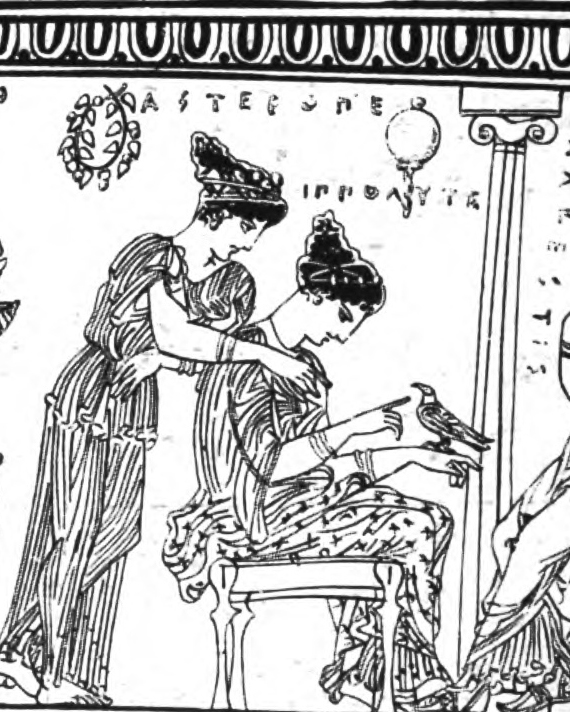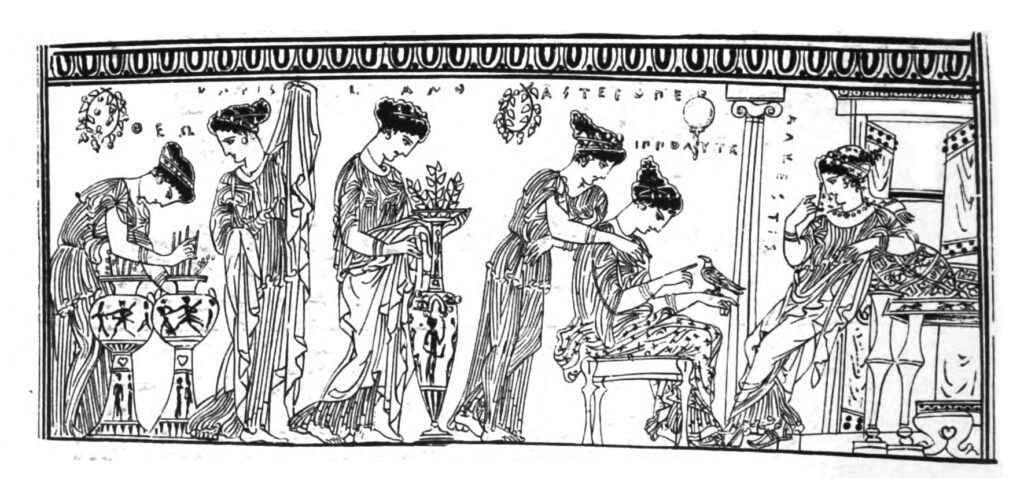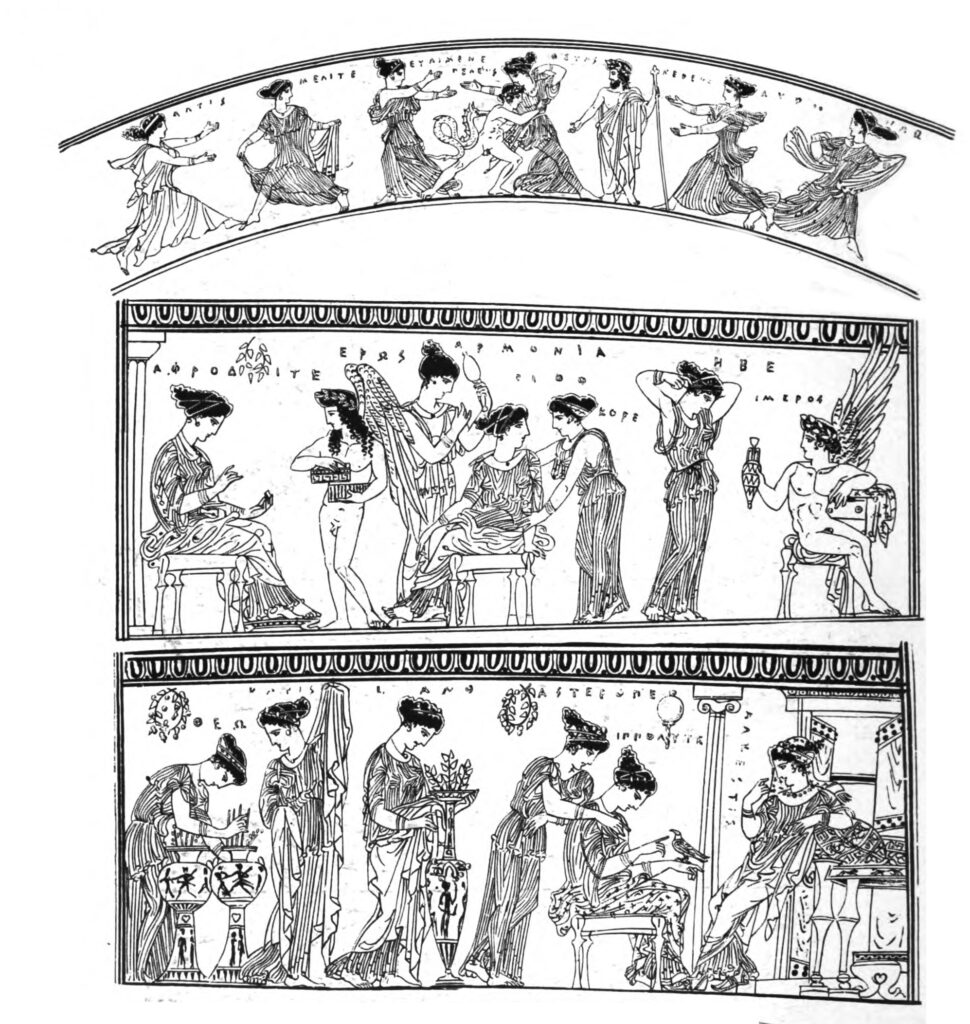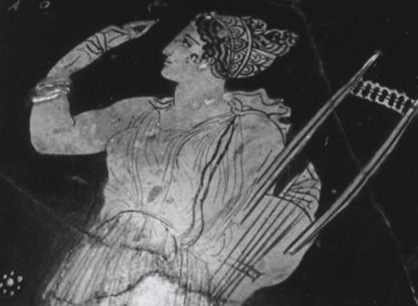2020.12.18 | By Gregory Nagy
§0. In this essay, I start by considering the word strouthoi, conventionally translated as ‘sparrows’, in Song 1 of Sappho. At line 10, these birds are seen at the moment when they take wing and fly off. They are pulling behind them, as they fly, the chariot of the goddess Aphrodite, conveying their divine mistress from her heavenly home and winging their way, full speed, through the vast stretches of ethereal space extending from the luminous Sky up above all the way down below to the dark soil of Earth, described at line 10 as ‘black’. In the twinkling of an eye, the goddess arrives, in instant response to an earthbound female’s cry for divine help in her pursuit of success in love. The earthly female is earthy in her appeal to the celestial female, and I deliberately say “earthy” here to imply an eroticism that is not sublime but earthbound, maybe even soiled, dirty. So also the earthy little sparrows that are pulling the chariot of the goddess, notorious as they are for their voracious sexual appetite, can be seen as soiled, dirty. And I would compare also the earthy little passer or ‘sparrow’ in Poems 2 and 3 of Catullus. This pet bird, belonging to that ‘girl from Lesbos’, Lesbia, is a poetic replication of the strouthoi or ‘sparrows’ we saw in Song 1 of Sappho. But these winged attendants of Aphrodite are to be contrasted in their earthiness with the heavenliness of two alternative attendants that we see pictured in a classical Athenian vase painting that I studied in a previous essay (Nagy 2020.12.04, linked here). These other attendants are heavenly cupids—humanoid Erotes fluttering with luxuriant swanlike wings that extend from their shoulders—and they too, like the sparrows in Song 1 of Sappho, are pictured as pulling the chariot of Aphrodite. The picturing of these heavenly Erotes brings me to the question I address in my essay here: despite the visible contrast between heavenly and earthy love-on-wings, is there anything heavenly—or at least sublime—about the earthy little sparrows of Aphrodite?



Further down: full view of Side A, which shows a scene from the wedding of Alcestis (to Admetus).
Still further down: full views of Side A and of Side B and of the top band. Side B of the epinētron shows a similar scene, from the wedding of Harmonia (to Kadmos), with Aphrodite and Eros among those attending. On the curved top band is a scene picturing the abduction of Thetis by Peleus. For the overall work, I cite the Beazley Archive, here. Drawings after E. Pfuhl, Malerei und Zeichnung der Griechen (Munich 1923) Fig. 561.
§1. A visual hint of sublimity, I think, is to be found in the close-up of a detail in the first picture that I show above to lead off the illustrations I have chosen for this essay. In this detail, taken from a painting by an Athenian artist known as the Eretria Painter, we see a female beauty, named Hippolyte in the adjacent inscription, who is playfully teasing with the tip of her finger a little bird. Affectionately leaning over this beauty’s shoulder is another female beauty, named Asterope, whose fingertip is aiming the same playfully teasing gesture at the bird. Observing all the playfulness is the bride, whose name is inscribed as Alcestis—she is the same heroine who is featured in the well-known drama of Euripides.
§2. There is another such detail in a picture painted by another Athenian artist, known as the Meidias Painter, and I have analyzed that painting in an earlier essay (Nagy 2020.11.13, linked here). I show again a close-up of the relevant detail:

§3. In my previous essay focusing on this picture painted by the Meidias Painter (again Nagy 2020.11.13, linked here), I had already argued that the little bird who is being playfully teased by the female beauty named Eurynoe in this painting can be compared to the pet sparrow who is playfully teased by Lesbia, poeticized as Sappho, in Poem 2 of Catullus. And now I can make a parallel argument about the little bird painted by the Eretria Painter.
§4. It may seem tempting at this point to ask a question: are the little birds that we see pictured by these Athenian painters really sparrows, like the pet bird of Lesbia in Poem 2 of Catullus? This question is moot, however, since we find “a poetics of fluidity” in erotic references to birds, as we read in a relevant essay by Natasha Bershadsky (2020.11.13, linked here). A more pertinent question, rather, would be this: what birds are sacred to Aphrodite in ancient Greek poetic traditions? And the answer is, we can see a wide variety, and the variations range from the sublime to the earthy. So, what needs to be studied is the range of traditional variations on the erotic theme of love-on-wings, as I referred to it in the title of this essay.
§5. For surveying the variety of birds known for their mythological as well as poetical links to Aphrodite, I recommend a careful reading of an article by Michael Turner (2005), “Aphrodite and her birds,” where he shows that the identity of the goddess can be linked not only with small sparrow-size birds but also with large birds, like swans. As Turner points out in passing (p. 84n127), there is even a vase painting that pictures Aphrodite riding on a chariot pulled by swans (Attic red figure squat lekythos, dated to around 400–375 BCE; Providence, Rhode Island, School of Design 25.085). Among the smaller birds of Aphrodite, a particular favorite of the goddess is the iunx or ‘wryneck’ (Iunx torquilla), as Turner (2005) shows, adducing a plethora of examples. So, I find it relevant that Lucilla Burn, in her valuable book on the Meidias Painter, thinks that the little bird that is being teased by the female beauty Eurynoe in the picture painted by this painter, as I show it above, is actually a iunx (Burn 1987:43; similarly Detienne [1977] 1994:85, Reitzammer 2016:45). But I need to add here three observations about such contexts of erotic representations involving winged conveyors of love:
A. There is room for other possibilities—for other possible kinds of small birds that may be on the minds of painters in the classical period of Athenian visual arts, and these other kinds of birds would include sparrows—as well as thrushes, warblers, larks, nightingales, and the list goes on.
B. Some of these small birds, such as the nightingale, are virtuoso singers, while others are not.
C. Some of these small birds, again, such as the nightingale, are suggestive of sublime sensuality— while others are exponents of the earthiest sexuality.
§6. In the light of the three observations I just made, a new question arises as I now proceed to reconsider the generic scenes of a female beauty’s playfulness with her little bird in the classical Athenian paintings. My new question is this: are we to think of the implied sexuality here as sublime or earthy? To say it another way, using the terms we find in the Symposium of Plato (180d–e), we could ask: are we thinking of Aphrodite here as Ouraniā or as Pandēmos? Is the goddess here ‘celestial’ or is she, shall we say, ‘vulgar’?
§7. There are, yes, traces of vulgarity, as when we see a female beauty gazing longingly at the plectrum of her lyre—at her ‘twanger’, as I called it in a previous essay (Nagy 2020.12.04, linked here):

As we know from Athenian Old Comedy (Nelson 2000), the word plēktron ‘plectrum, strummer’, which refers to the musical instrument for strumming on the lyre, could metaphorically be applied to a leather penis or dildo, and the same goes for the word olisbos, the non-metaphorical meaning of which is ‘plectrum, strummer’. So, we could be thinking that the female beauty who gazes longingly at the plectrum of her lyre is really looking, by transference, at a “phallic bird” that substitutes for the “real birds” fingered by other female beauties in classical Athenian paintings.
§8. Such thinking, however, can lead to careless formulations that are typical of today’s academic world, of which I admit I am a part, whether willing or unwilling. I will have more to say about such thinking in the essay that follows this one. For now, however, I will simply focus on the term ‘vulgar’. Even when I use this term’, as I just did when I referred to Plato’s understanding of Pandēmos as an epithet of Aphrodite that he contrasts with that other epithet of hers, Ouraniā, meaning ‘celestial’ (again, Symposium 180d–e), I find myself engaging in class-conscious subjectivities—just as the speakers dramatized by Plato are engaging in their own class-consciousnesses.
§9. Seeking refuge from subjective thinking about what is ‘vulgar’, I turn to linguistics. When linguists use the word ‘vulgar’, as when for example they refer to Vulgar Latin as opposed to Classical Latin, their aim is not to distinguish subjectively what is lower-class as opposed to upper-class. All they are trying to do is to distinguish objectively what has survived—or, better, what lives on—in the so-called Romance languages of the present as opposed to the “Classical” Latin of the past. So, when it comes to such problems as trying to visualize the little pet bird of Lesbia in Poem 2 of Catullus, whom he calls a passer, I find refuge in the etymological dictionary of Alfred Ernout and Antoine Meillet in the case of Classical Latin (I use the fourth edition, 1959) and in that of Wilhelm Meyer-Lübke in the case of Romance (I use the third edition, 1935). When I look up passer in the dictionary of Ernout and Meillet (at page 486), I find that it means ‘sparrow’ in some Latin contexts and, more generically, ‘bird’ in other contexts. And our linguists now add, in a one-word sentence, a narrative for what happens in Latin and after Latin, as it were. Here is their one-word sentence: “Panroman.” That is to say, you can find survivals of Vulgar Latin passer / passar attested in all Romance languages. Following up, this etymological dictionary of Classical Latin by Ernout and Meillet now sends you off to the etymological dictionary of Romance languages, bv Meyer-Lübke, who informs you, when you look up the word under its Classical Latin form, passer (entry number 6268), that this word lives on with the specific meaning ‘sparrow’ in some Romance languages, as we see for example in Italian passero, or with the generic meaning ‘bird’ in other Romance languages, as we see for example in Spanish pájaro.
§10. So, the empirical evidence collected by linguists can help us think of Lesbia’s little pet bird in Poem 2 of Catullus as either a sparrow or, more simply, as any kind of a small bird. This evidence may seem not all that helpful for literary critics whose desire is to decide between a sparrow, specifically, or a bird, generically. But I find this same evidence most helpful in my own efforts to find a link between the Latin word passer in Poem 2 of Catullus and the Greek word strouthoi in Song 1 of Sappho. In the case of Greek strouthos, I think we see a comparable range of meanings, between ‘sparrow’, specifically, and a wide variety of other kinds of birds, generically. And that variety, as the evidence of ancient Greek visual arts can show us, includes not only small birds, such as sparrows or wrynecks, but also big birds, such as swans. In the visual world of painters, one of many motivations for variation between, say, swans and sparrows is the symbolism of Aphrodite as goddess of sexuality in all its own varieties, ranging from extreme sublimity to extreme earthiness. I can apply here my model for interweavings of metaphor and metonym in terms of a vertical axis of selection and a horizontal axis of combination (Nagy 2016|2015 0§§04–06, 2§§01–03, building especially on the formulations of Jakobson 1990:119–120, 129). The vertical selector, in erotic situations involving winged conveyors of love, is Aphrodite herself, whose own sexuality ranges from heavenly to earthy—and back.
For bibliographical references, see the dynamic Cumulative Bibliography here.
